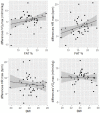Differences between Treadmill and Cycle Ergometer Cardiopulmonary Exercise Testing Results in Triathletes and Their Association with Body Composition and Body Mass Index
- PMID: 35329246
- PMCID: PMC8955092
- DOI: 10.3390/ijerph19063557
Differences between Treadmill and Cycle Ergometer Cardiopulmonary Exercise Testing Results in Triathletes and Their Association with Body Composition and Body Mass Index
Abstract
Cardiopulmonary exercise testing (CPET) is the method of choice to assess aerobic fitness. Previous research was ambiguous as to whether treadmill (TE) and cycle ergometry (CE) results are transferrable or different between testing modalities in triathletes. The aim of this paper was to investigate the differences in HR and VO2 at maximum exertion between TE and CE, at anaerobic threshold (AT) and respiratory compensation point (RCP) and evaluate their association with body fat (BF), fat-free mass (FFM) and body mass index (BMI). In total, 143 adult (n = 18 female), Caucasian triathletes had both Tr and CE CPET performed. The male group was divided into <40 years (n = 80) and >40 years (n = 45). Females were aged between 18 and 46 years. Body composition was measured with bioelectrical impedance before tests. Differences were evaluated using paired t-tests, and associations were evaluated in males using multiple linear regression (MLR). Significant differences were found in VO2 and HR at maximum exertion, at AT and at RCP between CE and TE testing, in both males and females. VO2AT was 38.8 (±4.6) mL/kg/min in TE vs. 32.8 (±5.4) in CE in males and 36.0 (±3.6) vs. 32.1 (±3.8) in females (p < 0.001). HRAT was 149 (±10) bpm in TE vs. 136 (±11) in CE in males and 156 (±7) vs. 146 (±11) in females (p < 0.001). VO2max was 52 (±6) mL/kg/min vs. 49 (±7) in CE in males and 45.3 (±4.9) in Tr vs. 43.9 (±5.2) in females (p < 0.001). HRmax was 183 (±10) bpm in TE vs. 177 (±10) in CE in males and 183 (±9) vs. 179 (±10) in females (p < 0.001). MLR showed that BMI, BF and FFM are significantly associated with differences in HR and VO2 at maximum, AT and RCP in males aged >40. Both tests should be used independently to achieve optimal fitness assessments and further training planning.
Keywords: heart rate; triathlon training; ventilation.
Conflict of interest statement
SW is the owner of the Sportslab clinic. Other authors have no conflict to declare.
Figures

Similar articles
-
Transferability of Cardiopulmonary Parameters between Treadmill and Cycle Ergometer Testing in Male Triathletes-Prediction Formulae.Int J Environ Res Public Health. 2022 Feb 6;19(3):1830. doi: 10.3390/ijerph19031830. Int J Environ Res Public Health. 2022. PMID: 35162854 Free PMC article.
-
Transferability of running and cycling training zones in triathletes: implications for steady-state exercise.J Strength Cond Res. 2009 Jan;23(1):251-8. doi: 10.1519/JSC.0b013e31818767e7. J Strength Cond Res. 2009. PMID: 19057406
-
VO2max prediction based on submaximal cardiorespiratory relationships and body composition in male runners and cyclists: a population study.Elife. 2023 May 10;12:e86291. doi: 10.7554/eLife.86291. Elife. 2023. PMID: 37162318 Free PMC article. Clinical Trial.
-
COVID-19 and athletes: Endurance sport and activity resilience study-CAESAR study.Front Physiol. 2022 Dec 16;13:1078763. doi: 10.3389/fphys.2022.1078763. eCollection 2022. Front Physiol. 2022. PMID: 36589442 Free PMC article.
-
The effect of test modality on dynamic exercise biomarkers in children, adolescents, and young adults.Physiol Rep. 2019 Jul;7(14):e14178. doi: 10.14814/phy2.14178. Physiol Rep. 2019. PMID: 31353834 Free PMC article.
Cited by
-
Assessing the Accuracy of Smartwatch-Based Estimation of Maximum Oxygen Uptake Using the Apple Watch Series 7: Validation Study.JMIR Biomed Eng. 2024 Jul 31;9:e59459. doi: 10.2196/59459. JMIR Biomed Eng. 2024. PMID: 39083800 Free PMC article.
-
Resting metabolic rate and energy efficiency in response to an intensive 84-day combat-swimmer training in the German Armed Forces.Eur J Appl Physiol. 2025 Apr;125(4):1101-1114. doi: 10.1007/s00421-024-05659-0. Epub 2024 Nov 25. Eur J Appl Physiol. 2025. PMID: 39586886 Free PMC article.
-
Biomarkers of aging: from molecules and surrogates to physiology and function.Physiol Rev. 2025 Jul 1;105(3):1609-1694. doi: 10.1152/physrev.00045.2024. Epub 2025 Mar 20. Physiol Rev. 2025. PMID: 40111763 Free PMC article. Review.
-
Is the Ventilatory Efficiency in Endurance Athletes Different?-Findings from the NOODLE Study.J Clin Med. 2024 Jan 16;13(2):490. doi: 10.3390/jcm13020490. J Clin Med. 2024. PMID: 38256624 Free PMC article.
-
Highest oxygen consumption prediction: introducing variable theoretical proportional factors for different sports.Eur J Appl Physiol. 2025 Mar;125(3):687-696. doi: 10.1007/s00421-024-05625-w. Epub 2024 Oct 8. Eur J Appl Physiol. 2025. PMID: 39379729
References
-
- Guazzi M., Adams V., Conraads V., Halle M., Mezzani A., Vanhees L., Arena R., Fletcher G.F., Forman D.E., Kitzman D.W., et al. EACPR/AHA Scientific Statement. Clinical recommendations for cardiopulmonary exercise testing data assessment in specific patient populations. Circulation. 2012;126:2261–2274. doi: 10.1161/CIR.0b013e31826fb946. - DOI - PMC - PubMed
MeSH terms
LinkOut - more resources
Full Text Sources
Miscellaneous

